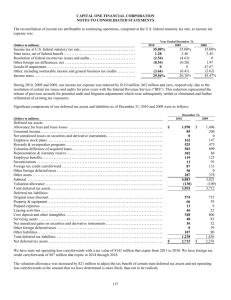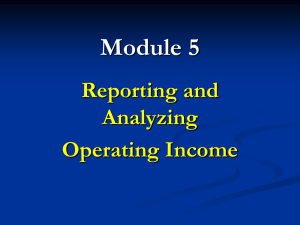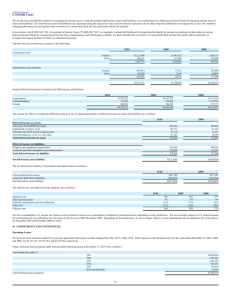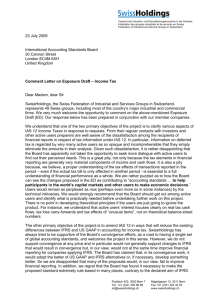International Accounting Standards Board,
advertisement
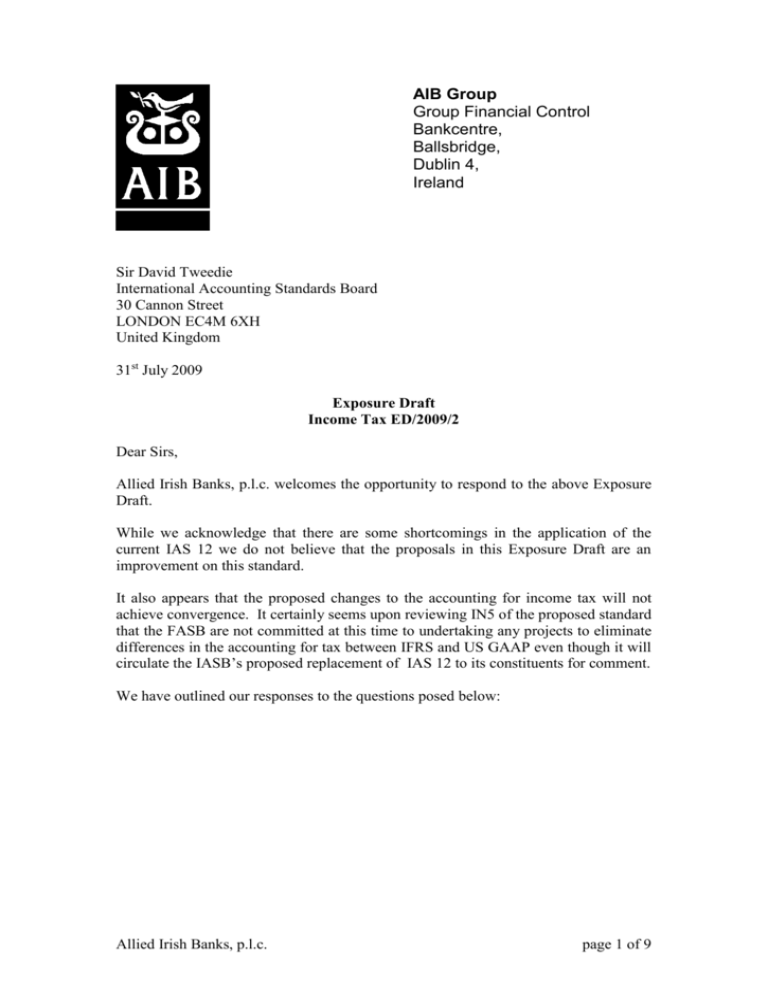
AIB Group Group Financial Control Bankcentre, Ballsbridge, Dublin 4, Ireland Sir David Tweedie International Accounting Standards Board 30 Cannon Street LONDON EC4M 6XH United Kingdom 31st July 2009 Exposure Draft Income Tax ED/2009/2 Dear Sirs, Allied Irish Banks, p.l.c. welcomes the opportunity to respond to the above Exposure Draft. While we acknowledge that there are some shortcomings in the application of the current IAS 12 we do not believe that the proposals in this Exposure Draft are an improvement on this standard. It also appears that the proposed changes to the accounting for income tax will not achieve convergence. It certainly seems upon reviewing IN5 of the proposed standard that the FASB are not committed at this time to undertaking any projects to eliminate differences in the accounting for tax between IFRS and US GAAP even though it will circulate the IASB’s proposed replacement of IAS 12 to its constituents for comment. We have outlined our responses to the questions posed below: Allied Irish Banks, p.l.c. page 1 of 9 Question 1 – Definitions of tax basis and temporary difference The exposure draft proposes changes to the definition of tax basis so that the tax basis does not depend on management’s intentions relating to the recovery or settlement of an asset or liability. It also proposes changes to the definition of a temporary difference to exclude differences that are not expected to affect taxable profit. (See paragraphs BC17 – BC23 of the Basis for Conclusions). Do you agree with the proposals? Why or why not? Answer 1 – Whilst we agree that changing the definition of the tax basis may lead to better comparability in the application of the proposed standard between reporting entities we do not agree with the proposal. Using the consequence of sale as a basis for the proposed definition would not reflect how banks manage their assets and liabilities. We feel it would be more appropriate for the definition to be based on assets held for use as opposed to the recovery or settlement of the asset. We agree with the proposed change to the definition of temporary differences to only include items whose settlement will have an affect on taxable profit. Question 2 – Definitions of tax credit and investment tax credit The exposure draft would introduce definitions of tax credit and investment tax credit. (See paragraph BC24 of the Basis for Conclusions). Do you agree with the proposed definitions? Why or why not? Answer 2 – We agree that the final standard should include definitions of tax credits and investment tax credits. We agree with the definition of tax credit. However, we feel that the definition of investment tax credit could be more robust and the proposed standard should include more guidance on the recovery of the investment tax credit. This is a very important topic at present as governments in various jurisdictions are encouraging entities to engage in research and development by offering tax incentives. In many cases the expenditure that is being encouraged relates to assets which do not meet the definition of depreciable assets and the proposed standard does not cover such assets. Question 3 – Initial recognition exception The exposure draft proposes eliminating the initial recognition exception in IAS 12. Instead, it introduces proposals for the initial measurement of assets and liabilities that have tax bases different from their initial carrying amounts. Such assets and liabilities are disaggregated into (a) an asset or liability excluding entity-specific tax effects and (b) any entity specific tax advantage or disadvantage. The former is recognised in accordance with applicable standards and a deferred tax asset or liability is recognised for any temporary difference between the resulting carrying amount and the tax basis. Outside a business combination or a transaction that affects accounting or taxable profit, any difference between the consideration paid or received and the total amount Allied Irish Banks, p.l.c. page 2 of 9 of the acquired assets and liabilities (including deferred tax) would be classified as an allowance or premium and recognised in comprehensive income in proportion to changes in the related deferred tax asset or liability. In a business combination, any such difference would affect goodwill. (See paragraphs BC25-BC35 of the Basis for Conclusions). Do you agree with the proposals? Why or why not? Answer 3 – In general we agree with the revised guidance that replaces the initial recognition exception in IAS 12 however, we feel more guidance is required as certain elements of the proposed standard are unclear. There should be more clarity on the treatment of the allowance and premium accounts as regards how and where in the accounts they should be recognised. Question 4 – Investments in subsidiaries, branches, associates and joint ventures. IAS 12 includes an exception to the temporary difference approach for some investments in subsidiaries, branches, associates and joint ventures based on whether an entity controls the timing of the reversal of the temporary difference and the probability of it reversing in the foreseeable future. The exposure draft would replace these requirements with the requirements in SFAS 109 and APB Opinion 23 Accounting for Income Tax – Special Areas pertaining to the difference between the tax basis and the financial reporting carrying amount for an investment in a foreign subsidiary or joint venture that is essentially permanent in duration. Deferred tax assets and liabilities for temporary differences related to such investments are not recognised. Temporary differences associated with branches would be treated in the same way as temporary differences associated with investment in subsidiaries. The exception in IAS 12 relating to investments in associates would be removed. The board proposes this exception from the temporary difference approach because the Board understands that it would often not be possible to measure reliably the deferred tax asset or liability arising from such temporary differences. (See paragraphs BC39-BC44 of the Basis for Conclusions). Do you agree with the proposals? Why or why not? Do you agree that it is often not possible to measure reliably the deferred tax asset or liability arising from temporary differences relating to an investment in a foreign subsidiary or joint venture that is essentially permanent in duration? Should the Board select a different way to define the type of investments for which this is the case? If so, how should it define them? Answer 4 - In our opinion the existing exemption should be retained. It does not make sense to keep the exemption for foreign operations but not domestic operations. Question 5 – Valuation allowances The exposure draft proposes a change to the approach to the recognition of deferred tax assets. IAS 12 requires a one-step recognition approach of recognising a deferred Allied Irish Banks, p.l.c. page 3 of 9 tax asset to the extent that its realisation is probable. The exposure draft proposes instead that deferred tax assets should be recognised in full and an offsetting valuation allowance recognised to that the net carrying amount equals the highest amount that is more likely than not to be realisable against taxable profit. (See paragraphs BC52BC55 of the Basis for Conclusions). Question 5A Do you agree with the recognition of a deferred tax asset in full and an offsetting valuation allowance? Why or why not? Answer 5A – yes we agree with the recognition of a deferred tax asset in full and an off-setting valuation allowance. Question 5B Do you agree that the net amount to be recognised should be the highest amount that is more likely than not to be realisable against future taxable profit? Why or why not? Answer 5B – yes we agree that the net amount recognised should be the highest amount that is more likely than not to be realisable against future taxable profit. Question 6 – Assessing the need for a valuation allowance Question 6A The exposure draft incorporates guidance from AFAS 109 on assessing the need for a valuation allowance. (See paragraph BC56 of the Basis for Conclusions). Do you agree with the proposed guidance? Why or why not? Answer 6A – We are in agreement with the inclusion of the above guidance. While it could be difficult to make an estimate of items far into the future, the fact that paragraph B 19 requires entities to adjust the amount of the valuation allowance to the extent that it has become more likely than not that future taxable profit will allow more or less of the deferred tax asset to be realised, will mean that the valuation allowance is constantly reviewed. Question 6B The exposure draft adds a requirement on the cost of implementing a tax strategy to realise a deferred tax asset. (See paragraph BC56 of the Basis for Conclusions). Do you agree with the proposed requirement? Why or why not? Answer 6B – The requirement to add the cost of implementing a tax strategy in the valuation seems particularly onerous. It is not in keeping with the treatment of other professional fees incurred. Allied Irish Banks, p.l.c. page 4 of 9 Question 7 – Uncertain tax positions IAS 12 is silent on how to account for uncertainty over whether the tax authority will accept the amount reported to it. The exposure draft proposes that current and deferred tax assets and liabilities should be measured at the probability-weighted average of all possible outcomes, assuming that the tax authority examines the amounts reported to it by the entity and has full knowledge of all relevant information. (See paragraphs BC57-BC63 of the Basis for Conclusions). Do you agree with the proposals? Why or why not? Answer 7 – We agree that this issue needs to be dealt with in the proposed standard as divergent treatment of items of uncertainty could have a significant effect on the tax amounts recognised in the financial statements. However, applying probabilities to possible outcomes could be difficult or even onerous if there were a large number of uncertain items. Clarity may not be reached about the uncertain item for a number of months, possibly over a year. The question then arises as to whether this should be classified as current or deferred tax. Question 8 – Enacted or substantively enacted rate IAS 12 requires an entity to measure deferred tax assets and liabilities using the tax rates enacted or substantively enacted by the reporting date. The exposure draft proposes to clarify that substantive enactment is achieved when future events required by the enactment process historically have not affected the outcome and are unlikely to do so. (See paragraphs BC64-BC66 of the Basis for Conclusions). Do you agree with the proposals? Why or why not? Answer 8 – We agree with the guidance give on enacted substantially enacted. Question 9 – Sale rate or use rate When different rates apply to different ways in which an entity may recover the carrying amount of an asset, IAS 12 requires deferred tax assets and liabilities to be measured using the rate that is consistent with the expected manner of recovery. The exposure draft proposes that the rate should be consistent with the deductions that determine the tax basis, i.e. the deductions that are available on sale of the assets. If those deductions are available only on sale of the asset, then the entity should use the sale rate. If the same deductions are also available on using the asset, the entity should use the rate consistent with the expected manner of recovery of the asset. (See paragraphs BC67-BC73 of the Basis for Conclusions). Do you agree with the proposals? Why or why not? Allied Irish Banks, p.l.c. page 5 of 9 Answer 9 – In general we agree with the above proposal, however, there may be some confusion as regards “if the same deductions are also available…”. We feel this sentence is not adding value to the requirement that the “rate should be consistent with the deductions that determine the tax basis” which are the deductions that are available on the sale of the asset. We have however already stated in question 1 that we don’t agree with basing the definition of tax basis on the consequence of sale. Question 10 – Distributed or undistributed rate IAS 12 prohibits the recognition of tax effects of distributions before the distribution is recognised. The exposure draft proposes that the measurement of tax assets and liabilities should include the effect of expected future distributions, based on the entity’s past practices and expectations of future distributions. (See paragraphs BC74BC81 of the Basis for Conclusions). Do you agree with the proposals? Why or why not? Answer 10 - We do not agree with the above proposals. Including the effect of expected future distributions introduces subjectivity into the calculations which we feel should be based on actual distributions. Question 11 – Deductions that do not form part of a tax basis An entity may expect to receive tax deductions in the future that do not form part of a tax basis. SFAS 109 gives examples of ‘special deductions’ available in the US and requires that ‘the tax benefit of special deductions ordinarily is recognised no earlier than the year in which those special deductions are deductible on the tax return’. SFAS 109 is silent on the treatment of other deductions that do not form part of a tax basis. IAS 12 is silent on the treatment of tax deductions that do not form part of a tax basis and the exposure draft proposes no change. (See paragraphs BC82-BC88 of the Basis for Conclusions). Do you agree that the exposure draft should be silent on the treatment of tax deductions that do not form part of a tax basis? If not, what requirements do you propose, and why? Answer 11 - Yes we agree that the exposure draft should be silent in this regard. Question 12 – Tax based on two or more systems In some jurisdictions, an entity may be required to pay tax based on one of two or more tax systems, for example, when an entity is required to pay the greater of the normal corporate income tax and a minimum amount. The exposure draft proposes that an entity should consider any interaction between tax systems when measuring deferred tax assets and liabilities. (See paragraph BC89 of the Basis for Conclusions). Allied Irish Banks, p.l.c. page 6 of 9 Do you agree with the proposals? Why or why not? Answer 12 - Yes we agree with the above proposal, an entity should consider any interaction between tax systems if they exist in a jurisdiction. Question 13 – Allocation of tax components of comprehensive income and equity IAS 12 and SFAS 109 require the tax effects of items recognised outside continuing operations during the current year to be allocated outside continuing operations. IAS 12 and SFAS 109 differ, however, with respect to the allocation of tax related to an item that was recognised outside continuing operations in a prior year. Such items may arise from changes in the effect of uncertainty over the amounts reported to the tax authorities, changes in assessments of recovery of deferred tax assets or changes in tax rates, laws, or the taxable status of the entity. IAS 12 requires the allocation of such tax outside continuing operations, whereas SFAS 109 requires allocation to continuing operations, with specified exceptions. The IAS 12 approach is sometimes described as requiring backwards tracing and the SFAS 109 approach as prohibiting backwards tracing. The exposure draft proposes adopting the requirements in SFAS 109 on the allocation of tax to components of comprehensive income and equity. (See paragraphs BC90-BC96 of the Basis for Conclusions). Question 13A Do you agree with the proposed approach? Why or why not? The exposure draft deals with allocation of tax to components of comprehensive income and equity in paragraphs 29-34. The Board intends those paragraphs to be consistent with the requirements expressed in SFAS 109. Question 13B Would those paragraphs produce results that are materially different from those produced under the SFAS 109 requirements? If so, would the results provide more or less useful information than that produced under SFAS 109? Why? The exposure draft also sets out an approach based on the IAS 12 requirements with some amendments. (See paragraph BC97 of the Basis for Conclusions). Question 13C Do you think such an approach would give more useful information than the approach proposed in paragraphs 29-34? Can it be applied consistently in the tax jurisdiction with which you are familiar? Why or why not? Question 13D Would the proposed additions to the approach based on the IAS 12 requirements help achieve a more consistent application of that approach? Why or why not? Allied Irish Banks, p.l.c. page 7 of 9 Answer 13 – While we accept that from a convergence point of view some amendments have to be made to deal with the differences between IAS 12 and SFAS 109 we do not agree with the above proposals. We feel that tax arising in a later period should follow the treatment in the earlier period, i.e. outside continuing operations. Inconsistency in this matter would make the accounts confusing from the user’s point of view and would make comparability between different accounting periods difficult. Question 14 – Allocation of current and deferred taxes within a group that files a consolidated tax return IAS 12 is silent on the allocation of income tax to entities within a group that files a consolidated tax return. The exposure draft proposes that a systematic and rational methodology should be used to allocate the portion of the current and deferred income tax expense for the consolidated entity to the separate or individual financial statements of the group members. (See paragraph BC100 of the Basis for Conclusions). Do you agree with the proposals? Why or why not? Answer 14 – We agree with the proposals outlined in the exposure draft. We agree that a method that is systematic and consistent with the standard is acceptable. Question 15 – Classification of deferred tax assets and liabilities The exposure draft proposes the classification of deferred tax assets and liabilities as current on non-current, based on the financial statement classification of the related non-tax asset or liability. (See paragraphs BC101 and BC102 of the Basis for Conclusions). Do you agree with the proposals? Why or why not? Answer 15 - While we can see the reasoning behind the above paragraph, by their nature deferred tax assets and liabilities are non current in that they are not expected to be recovered in the near future or within 12 months. The above does not take into account financial institutions who order their balance sheet by liquidity. In this case deferred tax assets and liabilities are usually within the assets and liabilities that are classified as more illiquid. If the above proposals were to come into practice it would be difficult for a financial institution to classify such assets and liabilities. Question 16 – Classification of interest and penalties IAS 12 is silent on the classification of interest and penalties. The exposure draft proposes that the classification of interest and penalties should be a matter of accounting policy choice to be applied consistently and that the policy chosen should be disclosed. (See paragraph BC103 of the Basis for Conclusions). Do you agree with the proposals? Why or why not? Allied Irish Banks, p.l.c. page 8 of 9 Answer 16 - We agree with the above in general, however it is to be assumed that for most entities interest and penalties would not be material. If they are material, the accounting policy should form part of the significant accounting policies of the entity within the financial statements. Question 17 – Disclosures The exposure draft proposes additional disclosures to make financial statements more informative. (See paragraphs BC104-BC109 of the Basis for Conclusions). Do you agree with the proposals? Why or why not? The Board also considered possible additional disclosures relating to un- remitted foreign earnings. It decided not to propose any additional disclosure requirements. (See paragraph BC110 of the Basis for Conclusions).Do you have any specific suggestions for useful incremental disclosures on this matter? If so, please provide them. Answer 17 – We feel that the disclosure requirements in the ED are extensive. We recognise the need for more transparency but feel that some disclosures could be difficult for preparers to achieve, for example 48 (g) which is a disclosure for entities not subject to tax. Question 18 – Effective date and transition Paragraphs 50-52 of the exposure draft set out the proposed transition for entities that use IFRSs, and paragraph C2 sets out the proposed transition for first-time adopters. (See paragraphs BC111-BC120 of the Basis for Conclusions). Do you agree with these proposals? Why or why not? Answer 18 – We agree with the transition proposals as described in the exposure draft. If you require clarification with regard to the above, please do not hesitate to contact me. Yours sincerely ____________________ Maura Murphy Accounting Policies Team Allied Irish Banks, p.l.c. page 9 of 9




